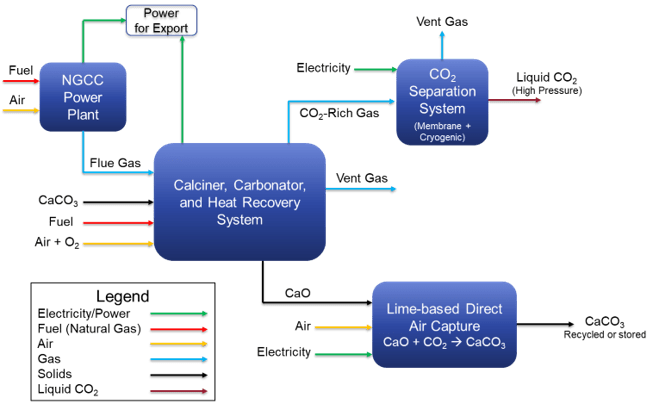In a recent report, the International Energy Agency emphasized that technological advances for decarbonizing energy services in buildings, transport, and heavy industry are critical for reaching net-zero carbon emissions by mid-century. Inspired by this need, the sustainable energy transistions (SET) group is interested in technology conceptualization, analysis and optimization for serving a range of final energy uses in a low-carbon and cost-effective manner.
As an example, the figure below illustrates a novel concept for flexible, low-carbon power generation using natural gas that integrates direct air capture (DAC) and flue gas CO2 capture to address the dual challenge of lower carbon power while providing grid flexibility. The process combines three main technologies, namely calcium looping, membrane and cryogenic separation, and lime-based DAC and incorporates flue gas from a conventional natural gas combined cycle (NGCC) power plant. Process units (DAC, calciner and separation system) can operate continuously to handle the feed CaCO3 even when NGCC plant is shut down, meaning that the process can operate flexibly in response to variations in the flue gas feed.

Relevant Past Projects
- Synthesis of carbon-efficient biofuel production routes using supplemental solar energy
- High efficiency approaches for converting solar thermal energy to hydrogen and electricity
- Design and Analysis carbon-based energy storage cycles
- Power Plant CO2 capture integrated with lime-based direct air capture
- Systematic assessment of nuclear-based integrated electricity and H2 production under low-carbon scenarios in the U.S. context
Relevant Ongoing Projects
- Center for Decarbonizing Chemical Manufacturing Using Sustainable Electrification
- Atoms-to-enterprise analysis for decarbonization of chemical manufacturing – case study of ethylene
- Pathways Towards Gigaton Scale Low-Carbon H2 production
- Multi-scale design of liquid hydrogen carriers for spatio-temporal balancing of renewable energy systems
Recent Publications
- Sheha, M., Graham, E.J., Gençer, E., Mallapragada, D., Herzog, H., Cross, P., Custer, J., Goff, A., and Cormier, I. (2024). Techno-economic analysis of a combined power plant CO2 capture and direct air capture concept for flexible power plant operation. Computers & Chemical Engineering 180, 108472. 10.1016/j.compchemeng.2023.108472.
- Zang, G., Graham, E.J., and Mallapragada, D. (2023). H2 production through natural gas reforming and carbon capture: A techno-economic and life cycle analysis comparison. International Journal of Hydrogen Energy. 10.1016/j.ijhydene.2023.09.230.
- Bose, A., Lazouski, N., Gala, M.L., Manthiram, K., and Mallapragada, D.S. 2022. Spatial Variation in Cost of Electricity-Driven Continuous Ammonia Production in the United States. ACS Sustain. Chem. Eng. (link)
- Isaacs, S.A., Staples, M.D., Allroggen, F., Mallapragada, D.S., Falter, C.P. and Barrett, S.R., 2021. Environmental and Economic Performance of Hybrid Power-to-Liquid and Biomass-to-Liquid Fuel Production in the United States. Environmental Science & Technology. 55(12), 8247-8257. (link)